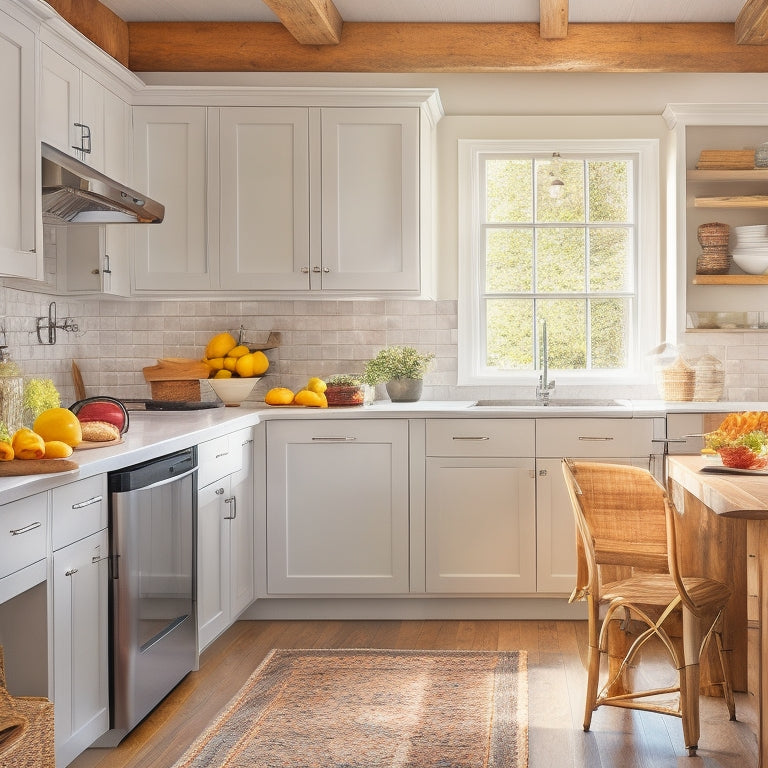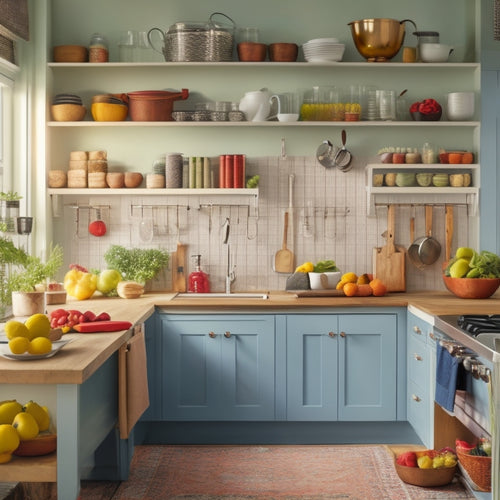
Organize Your Kitchen Without Breaking the Bank
Share
You can organize your kitchen without breaking the bank by starting with a thorough decluttering session, where you sort items into keep, donate/sell, and discard piles. Be ruthless in getting rid of unused items, and then categorize the keepers by function or frequency of use. Repurpose containers like mason jars or plastic containers to store frequently used items, and get creative with shelving ideas, like using a ladder as a makeshift shelving unit. Next, utilize vertical space efficiently with hanging baskets and wall hooks, and create a kitchen zone system to optimize your kitchen layout. Now, you're ready to take your kitchen organization to the next level.
Key Takeaways
• Sort and declutter items into keep, donate/sell, and discard piles to free up space and reduce waste.
• Repurpose items like mason jars, ladders, and cardboard boxes to create cost-effective storage solutions.
• Utilize vertical space with hanging baskets, wall hooks, and shelf risers to maximize storage without breaking the bank.
• Implement a kitchen zone system to optimize layout, reduce clutter, and enhance workflow without expensive renovations.
• Use cost-effective labeling strategies like chalkboard or whiteboard labels to easily identify contents and maintain organization.
Declutter Before You Organize
Before you start organizing your kitchen, take everything out of your cabinets and drawers and sort items into three piles: keep, donate/sell, and discard. This step is essential in decluttering your kitchen efficiently. Be ruthless – if you haven't used it in the past year, it's likely you won't miss it. Donate unused items that are still in good condition or sell clutter that's worth something. This won't only free up space but also generate some cash or goodwill.
Once you've purged your kitchen of unwanted items, you can focus on simplifying storage. Take stock of what you have left and categorize items by function or frequency of use. This will help you determine the most efficient way to store them. For instance, store frequently used items in easy-to-reach locations, and less frequently used items towards the back or on higher shelves.
Repurpose Items You Already Own
Now that you've decluttered and simplified your kitchen storage, turn your attention to repurposing items you already own to maximize their functionality and save money. Take a closer look at the containers you've kept – can you upcycle them to serve a new purpose?
Old mason jars can become spice containers or pen holders, while plastic containers can be transformed into desk organizers or utensil holders. Get creative with your shelving ideas too! Use an old bookshelf to store cookbooks, kitchen gadgets, or even plates.
You can also repurpose a ladder as a makeshift shelving unit for your cookbooks or infrequently used kitchen items. By repurposing these items, you'll not only reduce waste but also add a touch of personality to your kitchen. Plus, it's a cost-effective way to organize your kitchen without breaking the bank.
DIY Kitchen Storage Solutions
You can create your own kitchen storage solutions using materials you likely have lying around the house, such as cardboard boxes, fabric, or reclaimed wood. With a little creativity, you can turn these items into functional and stylish storage solutions.
For instance, you can use Mason jars to store spices, oils, or condiments, adding a touch of rustic charm to your kitchen.
Here are some DIY kitchen storage ideas to get you started:
-
Use hanging baskets to store fresh fruits, vegetables, or herbs, keeping them within easy reach.
-
Transform old cardboard boxes into drawer dividers or shelf organizers, adding a pop of color and texture to your kitchen.
-
Upcycle an old wooden crate into a utensil holder or knife block, adding a touch of industrial chic to your kitchen.
Utilize Vertical Space Efficiently
By maximizing your kitchen's vertical space, you can free up countertops and shelves, creating a more streamlined and organized cooking environment. One effective way to do this is by using hanging baskets and wall hooks to store items like pots, pans, utensils, and even herbs. This not only declutters your countertops but also adds a decorative touch to your kitchen.
Consider installing over the door storage racks or shelves to store infrequently used items like special occasion dishes, cookbooks, or small appliances. You can also use shelf risers to add extra storage space to your existing shelves. This is especially useful for storing items like plates, bowls, or cups, keeping them organized and easily accessible.
Create a Kitchen Zone System
Divide your kitchen into distinct zones, each dedicated to a specific task, such as food preparation, cooking, or clean-up, to create a more efficient and organized workspace. This zone organization approach optimizes your kitchen layout, allowing you to work smarter, not harder. By allocating specific areas for specific tasks, you'll reduce clutter, increase productivity, and enhance workflow efficiency.
Here are three key zones to contemplate:
-
Food Prep Zone: Designate an area near the sink for food preparation, including chopping, slicing, and dicing. This zone should include ample counter space, a trash can, and utensil storage.
-
Cooking Zone: Create a zone around your stove or cooktop, including a cooking surface, pots and pans storage, and utensils.
-
Clean-up Zone: Assign an area near the sink for cleaning and washing dishes, including a dishwasher, sink, and storage for cleaning supplies.
Maximize Cabinet Storage Space
Optimizing your cabinet storage space is essential to maintaining a clutter-free kitchen, and it starts with purging unnecessary items and assigning a home for everything else. You'll be amazed at how much space you can free up by getting rid of expired or duplicate items.
Once you've purged, categorize your remaining items into groups like baking, cooking, and storage. This will help you determine the most efficient way to store each group.
Next, use drawer dividers to separate items within your cabinets. This will keep similar items together and prevent clutter from building up again.
Consider installing hanging baskets on the back of cabinet doors to store spices, oils, or other small items. This will maximize vertical space and keep your countertops clear.
Shop Secondhand for Kitchen Items
You can score great deals on gently used kitchen items at a fraction of the cost of new ones by shopping at thrift stores, garage sales, or online marketplaces. This approach not only helps you save money but also reduces waste and gives new life to gently used items. When shopping secondhand, you'll be surprised at the quality and uniqueness of the items you can find.
Some of the best thrift store finds include:
-
Vintage kitchenware that adds a touch of personality to your kitchen decor
-
Budget-friendly kitchen upgrades like slow cookers, stand mixers, or blenders that are still in great condition
-
Unique decor pieces like antique utensils, ceramic vases, or retro-inspired posters that add visual interest to your kitchen
Invest in Multifunctional Tools
Stock your kitchen with multifunctional tools that can tackle various tasks, freeing up valuable storage space and streamlining your cooking process. By investing in these budget-friendly gadgets, you'll reduce clutter and make the most of your kitchen's real estate.
For instance, a food processor with multiple blades can chop, slice, and puree ingredients with ease, replacing the need for separate appliances.
Another space-saving essential is an Instant Pot or a pressure cooker, which can function as a slow cooker, rice cooker, and yogurt maker. These multifunctional tools won't only save you space but also reduce cooking time and cleanup.
Look for gadgets with adjustable settings, detachable parts, and compact designs to maximize their versatility. When choosing multifunctional tools, consider your cooking habits and the tasks you perform most frequently.
Optimize Your Kitchen Countertops
With your multifunctional tools in place, it's time to turn your attention to the surfaces that will be supporting them - your kitchen countertops. This is where the real magic happens, and a well-organized countertop can make all the difference in your cooking experience.
To optimize your kitchen countertops, focus on creating an efficient layout that allows you to move freely and access your tools with ease.
Here are some tips to get you started:
-
Clear the clutter: Remove any unnecessary items from your countertops to create a sense of openness and flow.
-
Group similar items together: Store frequently used items, such as spices or oils, in designated areas to save time and effort.
-
Add a stylish touch: Incorporate decorative elements, such as a vase or a small decorative tray, to add visual interest and personality to your countertops.
Use Labels to Stay Organized
Labeling your kitchen storage containers and shelves is a simple yet effective way to maintain organization and make sure that everything has its designated place. By doing so, you'll enjoy several labeling benefits, such as easy identification of contents, reduced clutter, and saved time searching for items.
To maximize these benefits, follow some essential organizing tips: use clear and concise labels, categorize similar items together, and keep labels at eye level for easy reading.
However, be mindful of common labeling mistakes that can negate these benefits. Avoid using labels that are too small or too vague, as they can be confusing and ineffective. Instead, get creative with your labeling solutions. For example, use color-coding to differentiate between categories or add icons to make labels more visual.
You can also use chalkboard or whiteboard labels that can be easily updated as your kitchen organization system evolves. By implementing these labeling strategies, you'll be able to maintain a clutter-free kitchen without breaking the bank.
Frequently Asked Questions
How Do I Maintain My Kitchen Organization Over Time?
To maintain your kitchen organization over time, you'll need to prioritize time management and decluttering tips. Set aside 10 minutes daily for consistent maintenance, and establish organizational systems that work for you, ensuring your kitchen stays tidy and efficient.
Can I Organize My Kitchen if I Have Limited Mobility?
"When life gives you lemons, make lemonade" - adapt to limited mobility by incorporating adaptive equipment into your kitchen layout. You can find budget-friendly solutions, such as creative storage options, to make cooking and organizing easier for you.
Are There Any Kitchen Organization Apps or Tools I Can Use?
You can utilize budget-friendly solutions like digital organization tools, such as apps like Sortly or Tody, to optimize your kitchen space, allowing you to efficiently manage your kitchen inventory and layout without overspending.
How Do I Involve My Family Members in Kitchen Organization?
"Get your family on board the kitchen organization train by assigning tasks, setting goals, and creating a 'division of labor' chart - it's a recipe for teamwork and a clutter-free kitchen that's achievable with minimal effort!"
Can I Organize My Kitchen if I Have a Small Kitchen?
You can absolutely organize a small kitchen! Focus on space-saving solutions and creative storage ideas to maximize your layout. Utilize vertical space by installing shelves or hooks, and implement decluttering tips to free up countertops.
Related Posts
-

5 Best Kitchen Organization Templates With Shopping Lists
You're looking to transform your kitchen into a culinary haven with the help of organization templates and shopping l...
